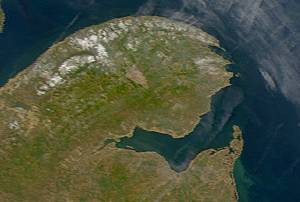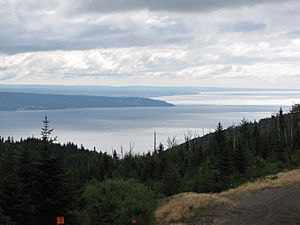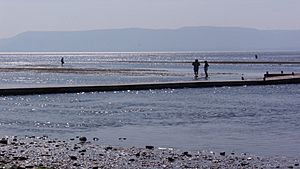Chaleur Bay facts for kids

Chaleur Bay, also called the "Bay of Warmth," is a large bay in Canada. It's located between the provinces of Quebec and New Brunswick. This beautiful bay is part of the larger Gulf of Saint Lawrence. The famous explorer Jacques Cartier gave it its French name, Baie des Chaleurs, which means "bay of warmth" or "bay of hot weather." It's even recognized as one of the Most Beautiful Bays of the World!
Chaleur Bay is also known for a strange sight called the Fireship of Chaleur Bay. People have reported seeing what looks like a burning ship in different parts of the bay. This mysterious sight might be connected to similar stories from other places, like the Fireship of Northumberland Strait. It has led to a legend about a phantom ship that is over 200 years old. The story says that a sailing ship burned near Campbellton, New Brunswick, possibly during the Battle of Restigouche. People claim you can still see it under certain weather conditions.
Contents
Exploring Chaleur Bay's Geography
Chaleur Bay opens up to the east. Its southern side is the northern coast of New Brunswick. The northern side is the southern coast of the Gaspé Peninsula in Quebec.
How Big is Chaleur Bay?
The bay is about 50 kilometers (31 miles) wide at its widest point. This is between Bathurst and New Carlisle. The western end of the bay connects to the Restigouche River estuary near Dalhousie, New Brunswick.
Beautiful Beaches of Chaleur Bay
The shores of Chaleur Bay have many beaches, especially on the New Brunswick side. Many rivers also create barachois, which are like natural sand barriers. One special sand bar is the Eel River Bar. It's unique because it has fresh water on one side and salt water on the other. It's also home to the endangered piping plover, a small bird.
People love to visit the bay's beaches in the summer. The ocean currents coming into the bay are warm. This makes the saltwater here some of the warmest on the Atlantic coast, north of Virginia!
Rivers Flowing into Chaleur Bay
Many rivers flow into Chaleur Bay, creating a strong smell of salt water, especially near the Restigouche River.
Here are some of the main rivers:
- In Quebec:
- Rivière Matapédia (flows into the Restigouche)
- Rivière Cascapédia
- Rivière Bonaventure
- Rivière du Grand Pabos
- Rivière du Petit Pabos
- Grande Rivière (Percé)
- In New Brunswick (from north to south):
- Upsalquitch River (flows into the Restigouche)
- Eel River
- Charlo River (home to Harlequin ducks)
- Benjamin River (also home to Harlequin ducks)
- Nash Creek
- Jacquet River
- Elmtree River
- Nigadoo River
- Millstream River
- Tetagouche River
- Middle River
- Nepisiguit River
- Between Quebec and New Brunswick:
- Restigouche River
- The Restigouche Estuary is very important for birds. It's the biggest resting area in eastern North America for Black scoter ducks.
- Patapédia River (flows into the Restigouche)
- Restigouche River
Islands in Chaleur Bay
Chaleur Bay has a few islands. The northern parts of Miscou Island and Lameque Island are part of the bay's southern shore. Heron Island is located near Dalhousie, New Brunswick, south of Carleton-sur-Mer, Quebec.
Chaleur Bay's Climate
The bay's shape and the tall cliffs on its northern side can make it very windy. This is especially true off Nepisiguit Bay. When the wind blows from the right direction and speed, the water can become quite rough. The ocean currents from the tides are usually not very strong, except near the mouths of some rivers.
A Look at Chaleur Bay's History
Many years ago, in 1832, about 500 people from Arran Island in Scotland moved to Chaleur Bay. They had to leave their homes during a time called the Highland Clearances. They started a new settlement here, which became very successful.
The eastern part of Chaleur Bay was also important during World War II. In September 1943, the Royal Canadian Navy had an operation here called Operation Pointe Maisonnette. This was part of the Battle of the St. Lawrence.
Amazing Animals of Chaleur Bay
Chaleur Bay is full of marine life! You can find many kinds of fish that live near the bottom of the sea, like ground fish. There are also lots of shellfish like lobsters and scallops.
Many of the bay's clean rivers are home to some of the biggest wild Atlantic salmon in the North Atlantic Ocean. This makes it a great place for people who enjoy angling (fishing).
You can also go whale watching in the bay. You might see amazing creatures like Fin whales. Recently, even North Atlantic right whales, which are very rare, have been seen more often in Chaleur Bay.
Chaleur Bay in Stories
Chaleur Bay is even mentioned in a famous poem! It appears in "Skipper Ireson's Ride" by John Greenleaf Whittier.
See also
 In Spanish: Bahía Chaleur para niños
In Spanish: Bahía Chaleur para niños



